External links
| This naval article is a stub. You can help Wikipedia by expanding it. |
The Over-the-horizon Airborne Sensor Information System (OASIS) is an organic over the horizon sensor targeting and surveillance system originally produced by Texas Instruments and now by Raytheon.
It is coupled with link 16, electro-optics/infrared, radar, GPS, Tactical Data Information Exchange System TADIX-B and Officer in Tactical Command Information Exchange System (OTCIXS) information to provide a coherent tactical picture for the user. OASIS III is a hybrid of OASIS and processes and correlates all data provided via Multi-Mission Advanced Tactical Terminal (MATT) and Mini-Demand Assigned Multiple Access (DAMA). The OASIS III tactical data processor provides an (OTCIXS) message link, coupled with GPS-aided targeting using the AN/APS-137B(V)5 Radar.
| This naval article is a stub. You can help Wikipedia by expanding it. |
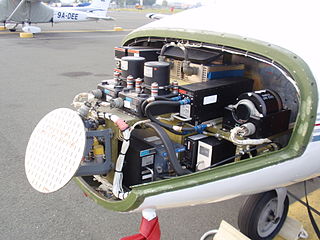
Avionics are the electronic systems used on aircraft, artificial satellites, and spacecraft, in short Avionic — the science of electronics when used in designing and making aircraft. Avionic systems include communications, navigation, the display and management of multiple systems, and the hundreds of systems that are fitted to aircraft to perform individual functions. These can be as simple as a searchlight for a police helicopter or as complicated as the tactical system for an airborne early warning platform. The term avionics is a portmanteau of the words aviation and electronics.

The TomahawkLand Attack Missile (TLAM) is a long-range, all-weather, jet-powered, subsonic cruise missile that is primarily used by the United States Navy and Royal Navy in ship- and submarine-based land-attack operations.

The Raytheon Company was a major U.S. defense contractor and industrial corporation with core manufacturing concentrations in weapons and military and commercial electronics. It was previously involved in corporate and special-mission aircraft until early 2007. Raytheon was the world's largest producer of guided missiles. In April 2020, the company merged with United Technologies Corporation to form Raytheon Technologies.
A guidance system is a virtual or physical device, or a group of devices implementing a guidance process used for controlling the movement of a ship, aircraft, missile, rocket, satellite, or any other moving object. Guidance is the process of calculating the changes in position, velocity, attitude, and/or rotation rates of a moving object required to follow a certain trajectory and/or attitude profile based on information about the object's state of motion.
Measurement and signature intelligence (MASINT) is a technical branch of intelligence gathering, which serves to detect, track, identify or describe the distinctive characteristics (signatures) of fixed or dynamic target sources. This often includes radar intelligence, acoustic intelligence, nuclear intelligence, and chemical and biological intelligence. MASINT is defined as scientific and technical intelligence derived from the analysis of data obtained from sensing instruments for the purpose of identifying any distinctive features associated with the source, emitter or sender, to facilitate the latter's measurement and identification.
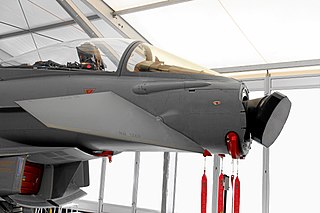
An active electronically scanned array (AESA) is a type of phased array antenna, which is a computer-controlled array antenna in which the beam of radio waves can be electronically steered to point in different directions without moving the antenna. In the AESA, each antenna element is connected to a small solid-state transmit/receive module (TRM) under the control of a computer, which performs the functions of a transmitter and/or receiver for the antenna. This contrasts with a passive electronically scanned array (PESA), in which all the antenna elements are connected to a single transmitter and/or receiver through phase shifters under the control of the computer. AESA's main use is in radar, and these are known as active phased array radar (APAR).

The Raytheon MIM-23 Hawk is an American medium-range surface-to-air missile. It was designed to be a much more mobile counterpart to the MIM-14 Nike Hercules, trading off range and altitude capability for a much smaller size and weight. Its low-level performance was greatly improved over Nike through the adoption of new radars and a continuous wave semi-active radar homing guidance system.
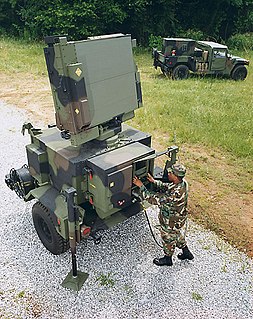
The AN/MPQ-64 Sentinel is a 3D radar used to alert and queue Short Range Air Defense (SHORAD) weapons to the locations of hostile targets approaching their front line forces. The Sentinel radar is deployed with forward area air defense units of the U.S. Army. It is an X-band range-gated, pulse-Doppler radar system. The antenna uses phase-frequency electronic scanning technology, forming sharp 3D pencil beams covering large surveillance and track volume. The radar automatically acquires, tracks, classifies, identifies and reports targets, including cruise missiles, unmanned aerial vehicles, and both rotary- and fixed-wing aircraft. It uses a high scan rate and operates at a range of 40 km (25 mi). The radar is designed with high resistance to electronic countermeasures (ECM). Mounted on a towed platform, it can be positioned remotely from the rest of the unit, operated autonomously and communicate with the Fire Direction Center (FDC) via wideband fiber-optic link. It can also distribute its data over a SINCGARS radio network.

The ADM-160 MALD is a decoy missile developed by the United States.

The AN/FPS-108 COBRA DANE is a PESA phased array radar installation operated by Raytheon for the United States Air Force at Eareckson Air Station on the island of Shemya, Aleutian Islands, Alaska. This radar system was built in 1976 and brought on-line in 1977 for the primary mission of intelligence gathering in support of verification of the SALT II arms limitation treaty. Its single face radar with a 29 m (95 ft) diameter phased array radar antenna 52.7373°N 174.0914°E faces the Kamchatka Peninsula and Kura Test Range. COBRA DANE operates in the 1215–1400 MHz band.
Raytheon Intelligence & Space (RIS) is one of the four business segments of U.S. defense and aerospace conglomerate Raytheon Technologies. Headquartered in Arlington, Virginia, RIS has a total employment of 39,000 and 2019 sales of US$ 15 billion. Roy Azevedo is the segment's President.
The Ship Self-Defense System (SSDS) is a combat system specifically designed for anti-air defense of aircraft carriers, and most other non-Aegis United States Navy combat ships. It coordinates several existing shipboard systems. Multi-sensor integration, parallel processing and the coordination of hard and soft kill capabilities are key components of the SSDS. Responses to airborne threats are based on automated or man-in-the-loop engagement doctrine.
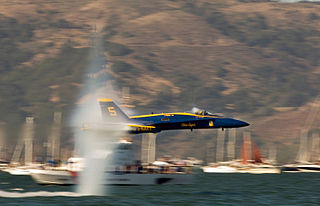
Sea skimming is a technique many anti-ship missiles and some fighter or strike aircraft use to avoid radar, infrared detection, and to lower probability of being shot down during their approach to the target.
Officer in Tactical Command Information Exchange System (OTCIXS) is used by the Global Command and Control System - Maritime (GCCS-M) as a means of transmitting tactical information on targets and non-targets for the purpose of creating situational awareness for tactical commanders in the field. It also provides the tactical information to strategic commanders far removed from the operational area. OTCIXS has moved from the Navy's primary means of tactical data communications to its secondary. OTCIXS is being phased out over time and replaced with other forms of information exchange such as Tactical Data Information Exchange Subsystem (TADIXS)

The AGM-176 Griffin is a lightweight, precision-guided munition developed by Raytheon. It can be launched from the ground or air as a rocket-powered missile or dropped from the air as a guided bomb. It carries a relatively small warhead, and was designed to be a precision low-collateral damage weapon for irregular warfare. It has been used in combat by the United States military during the War in Afghanistan.

The AMDR is an active electronically scanned array air and missile defense 3D radar under development for the United States Navy. It will provide integrated air and missile defense, and even periscope detection, for the Flight III Arleigh Burke-class destroyers.

Andrea Doria is a destroyer of the Italian Navy. She and her sister Caio Duilio form the Andrea Doria class; in turn these two ships, and the French vessels Forbin and Chevalier Paul, belong to the Horizon class. Andrea Doria has the hull number D 553 according to NATO classification.
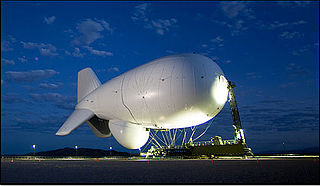
The Joint Land Attack Cruise Missile Defense Elevated Netted Sensor System, or JLENS, is a tethered aerial detection system designed to track boats, ground vehicles, cruise missiles, manned and unmanned aircraft, and other threats. The system has four primary components: two tethered aerostats which utilize a helium/air mix, armored mooring stations, sophisticated radars, and a processing station designed to communicate with anti-missile and other ground and airborne systems. Each system is referred to as an "orbit", and two orbits have been built. The Army-led joint program is designed to complement fixed-wing surveillance aircraft, saving money on crew, fuel, maintenance and other costs, and give military commanders advance warning to make decisions and provide notifications. The program was suspended in October 2015.

The AN/TPY-2 Surveillance Transportable Radar, also called the Forward Based X-Band Transportable (FBX-T) is a long-range, very high-altitude active electronically scanned array X band surveillance radar designed to add a tier to existing missile and air defence systems. It possess a range of 2,900 miles which equals to 4,700 km. Made by Raytheon, it is the primary radar for the Terminal High Altitude Area Defense (THAAD) missile system, but also cues the AN/MPQ-53 radar of the MIM-104 Patriot system. Patriot PAC-3 is a lower-altitude missile and air defense system than THAAD.